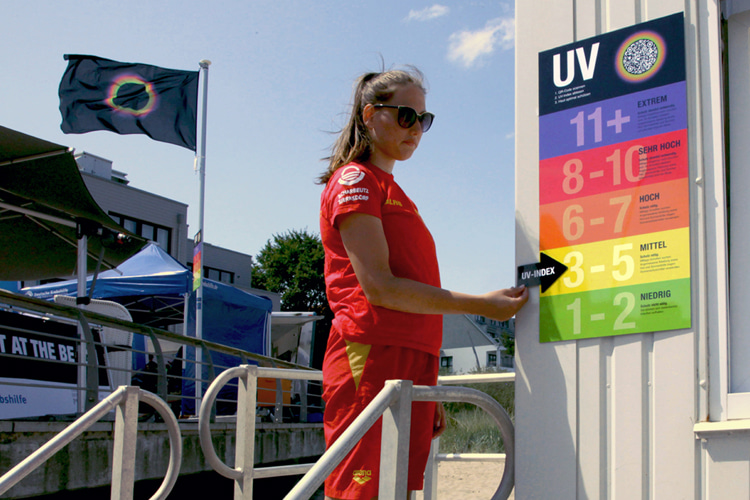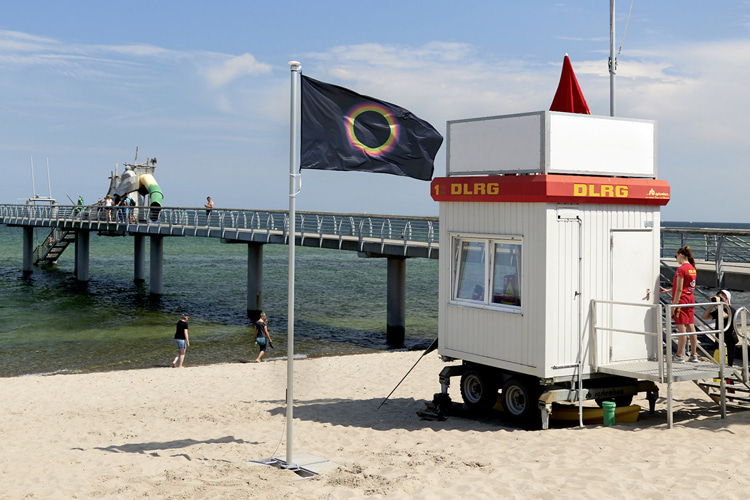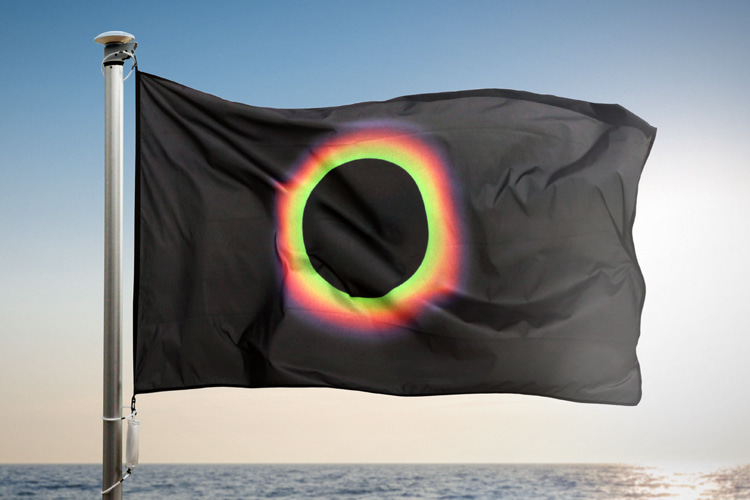Between bathing fun and the summer breeze, many people quickly underestimate the carcinogenic effects of the sun's UV radiation.
Every year, 400 people die in Germany by drowning, but eight times more die of melanomas caused by the sun.
"The fact is that even the smallest sunburn increases the risk of skin cancer - the most common type of tumor in Germany," warns Gerd Nettekoven, CEO of The German Cancer Aid.
As a result, an advertising agency (Heimat, Berlin), The German Cancer Aid, and several other organizations teamed up to launch a new type of beach warning flag.
Meet the world's first sun warning flag.
Right next to the well-known green flag (low hazard), yellow (hazard), or red flag (high hazard), a black flag (high skin cancer hazard) will be raised when the ultraviolet (UV) index reaches a critical level.
The brand-new sun warning flag features an eye-catching black-on-black design that displays an iconic black sun on a black flag based on the concept of melanoma.
Where the flag flies, beachgoers can see at a glance how dangerous the sun is for the skin on that day and how to behave and protect accordingly.
This is made possible by the UV index display on the flagpole. The distinctive color scale with values going from 1 to 11+ works like a traffic light.
If it is green, no special protection is required. However, if it is red, it's time to find some shade and adopt other appropriate sun protection measures.
The warning display is supported by an intuitive microsite that brings the UV index and other information to any user's mobile phone with one click.

UV Radiation: The Invisible Danger
The word melanoma comes from the Greek "melas," meaning "dark," and "oma," the expression for "tumor."
The iridescent aura of the black melanoma sun shows the color code of the United Nations World Health Organization (WHO) UV index, the international standard measurement of the strength of sunburn-producing radiation since 1994.
It goes from green (1) to purple (11+).
"By the time it starts to burn, itch, and the skin starts to turn red, the UV radiation has already done a lot of damage. This increases the risk of skin cancer," explains Professor Eckhard Breitbart, dermatologist and chairman of Germany's Working Group on Dermatological Prevention (ADP).
"We want to prevent this and clearly point out the danger of UV radiation."
As a result of global warming, there are more cloudless, sunny days, and the annual sunshine hours are increasing.
The carcinogenic UV radiation of the sun is imperceptible to human senses and destroys the genetic material (DNA) of skin cells in a matter of seconds.
The body reacts to this with a sophisticated repair mechanism, which, however, does not last long if there is too much sun.
Therefore, UV radiation from the sun and solariums is classified by WHO's International Agency for Research on Cancer (IARC) in the highest risk group I - "carcinogenic to humans."
This includes, for instance, asbestos.

A Future Standard Beach Flag
The new sun warning flag has been submitted to the International Organization for Standardization (ISO) and is expected to be implemented worldwide.
Nevertheless, the first use of the new warning sign started being tested at Timmendorfer Strand, a beach resort on Germany's Baltic Sea coastline.
It is managed by the German Life Saving Society (DLRG) and the local tourism board.
"Our volunteer lifeguards ensure that people are safe when swimming and bathing. That's why we're also happy to help protect bathers from UV radiation," adds Joachim Nitz, managing director of Timmendorfer Strand Niendorf Tourismus.
"Holidays and relaxation are necessary, so it is all the more important to us that our guests expose themselves to as few health hazards as possible and thus enjoy life on the beach carefree with the recommended measures."
The warning system will be evaluated and implemented on other beaches in Germany.
The ultimate goal is to bring the UV index into people's everyday lives and thus sustainably reduce the risk of skin cancer.
So, next time when you're at the beach, watch out for the newly launched sun warning flag. It is better to skip the day at the beach with a UV index of 8 or more.
Remember that the greatest danger by the sea is not the sea - it's the sun.
Ultraviolet Index | The Skin Cancer Scale
11+ Extremely High Risk
Protection is absolutely necessary.
If possible, don't be outside in the middle of the day. Stay in the shadows. Appropriate clothing, as well as a hat, sunglasses, and sunscreen, are a must.
10 - Very High Risk
Protection is absolutely necessary.
If possible, don't be outside in the middle of the day. Stay in the shadows. Appropriate clothing, as well as a hat, sunglasses, and sunscreen, are a must.
9 - Very High Risk
Protection is absolutely necessary.
If possible, don't be outside in the middle of the day. Stay in the shadows. Appropriate clothing, as well as a hat, sunglasses, and sunscreen, are a must.
8 - Very High Risk
Protection is absolutely necessary.
If possible, don't be outside in the middle of the day. Stay in the shadows. Appropriate clothing, as well as a hat, sunglasses, and sunscreen, are a must.
7 - High Risk
Protection needed.
Look for shade at midday. Wear appropriate clothing, a hat, and sunglasses. Use sunscreen.
6 - High Risk
Protection needed.
Look for shade at midday. Wear appropriate clothing, a hat, and sunglasses. Use sunscreen.
5 - High Risk
Protection needed.
Look for shade at midday. Wear appropriate clothing, a hat, and sunglasses. Use sunscreen.
4 - High Risk
Protection needed.
Look for shade at midday. Wear appropriate clothing, a hat, and sunglasses. Use sunscreen.
3 - High Risk
Protection needed.
Look for shade at midday. Wear appropriate clothing, a hat, and sunglasses. Use sunscreen.
2 - High Risk
Protection is not necessary.
You can stay outside without hesitation.
1 - High Risk
Protection is not necessary.
You can stay outside without hesitation.
